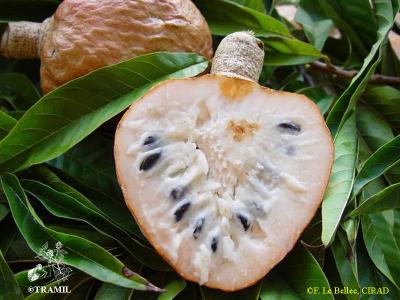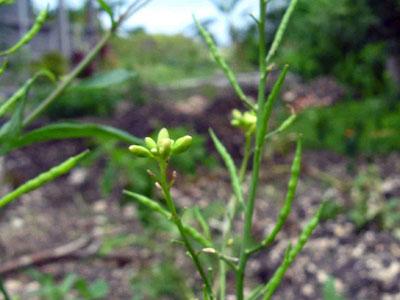(In territories with significant traditional TRAMIL use)
Haiti:
- cachimán
- coeur de boeuf
Dominican Republic:
- mamón
leaf, decoction sometimes with salt, orally1-2
According to the information available:
The use for sezisman (emotional shock) is classified as REC based on the significant traditional use documented in the TRAMIL surveys, the toxicity and validation studies and the scientific information published.
Because of the documented risk of neurotoxicity3-5 of the tetrahydroisoquinoline alkaloids and annonacin6 present in the leaf that have been associated with the appearance of atypical Parkinsonism3-6, avoid prolonged consumption (longer than one year).
Not for use during pregnancy, breastfeeding or in children under 12 years.
For sezisman (emotional shock):
prepare a decoction with 30 g of fresh leaves in 4 cups (1 litre) of water, with or without 1 teaspoon (5 milligrams) of salt, boil for 5 minutes in an covered vessel. Leave to cool, strain (filter) and drink 1 cup 3 to 4 times a day.
Preparations must never be stored for more than 24 hours, even if refrigerated.
1 WENIGER B, ROUZIER M, 1986
Enquête TRAMIL. Service Oecuménique d'Entraide SOE, Port au Prince, Haïti.
2 WENIGER B, 1987-88
Encuesta TRAMIL. enda-caribe, Santo Domingo, Rep. Dominicana.
3 CAPARROS-LEFEBVRE D, ELBAZ A, 1999
Possible relation of atypical parkinsonism in the French West Indies with consumption of tropical plants: a case-control study. The Lancet 354(9175):281-286.
4 FORGACS P, DESCONCLOIS JF, MANSARD D, PROVOST J, TIBERGHIEN R, TOCQUER J, TOUCHE A, 1981
Dopamine and tetrahydroisoquinoline alkaloids of Annona reticulata L., Annonaceae. Plant Med Phytother 15:10-15.
5 CHAMPY P, 2004
Étude chimique et biologique des neurotoxines d’Annona muricata L. (Annonaceae) pouvant être impliquées dans la survenue des parkinsonismes atypiques en Guadeloupe. Doctorat de l’Université Paris-Sud 11, France.
6 LANNUZEL A, MICHEL PP, GLINGER GU, CHAMPY P, JOUSSET A, MEDJA F, LOMBE A, DARIOS F, GLEYE C, LAURENS A, HOCQUEMILLER R, HIRSCH EC, RUBERG M, 2003
The mitochondrial complex I inhibitor annonacin is toxic to mesencephalic dopaminergic neurons by impairment of energy metabolism. Neuroscience 121(2):287–296.
7 WENIGER B, SAVARY H, SATURNE A, 1986
Tri phytochimique relatif à 4 plantes TRAMIL. Laboratoire de chimie des substances naturelles, Faculté de médecine et de pharmacie, Université d'Etat d'Haïti, Port au Prince, Haïti.
8 WATT J, BREYER-BRETWIJK M, 1962
The medicinal and poisonus plants of southern and eastern Africa. 2nd ed. Edinburgh, UK: Livingstone Ltd.
9 PARIS R, MOYSE H, 1981
Précis de matière médicale. Paris, France: Ed. Maloine.
10 YANG TH, CHENG MY, 1987
The alkaloids of Annona reticulata L II. Taiwan Yao hsueh 39(3):195-201.
11 OGUNTIMEIN B, 1987
The terpenoids of Annona reticulata. Fitoterapia 58(6):411-413.
12 CHANG FR, WU YC, DUH CY, WANG SK, 1993
Studies on the acetogenins of Formosan annonaceous plants. II. Cytotoxic acetogenins from Annona reticulata. J of Nat Products 56(10):1688-1694.
13 OGUNWANDE IA, EKUNDAYO O, OLAWORE NO, KASALI AA, 2006
Essential Oil of Annona reticulata L. Leaves from Nigeria. J of Essential Oil Research 18(4):374-376.
14 GARCÍA GM, COTO MT, GONZÁLEZ CS, PAZOS L, 1996
Toxicidad crónica en ratones, del extracto acuoso de hojas frescas de Annona reticulata. Informe TRAMIL. Laboratorio de Ensayos Biológicos, Universidad de Costa Rica, San Pedro, Costa Rica.
15 MARCY R, 1987
Annona reticulata et Annona muricata, recherche d'une activité sédative. Rapport TRAMIL, Université de Rouen, France.
16 ROLLAND A, Soulimani R, Martin A, Marchal E, Younos C, Fleurentin J, 1988
Recherche de quelques activités pharmacologiques traditionnelles d'Annona muricata et d'Annona reticulata chez l'animal. Rapport TRAMIL. Université de Metz, France.
17 LÓPEZ M, MOREJÓN Z, MARTÍNEZ MJ, BACALLAO Y, FUENTES V, 2009
Toxicidad aguda oral a dosis repetidas de decocción al 50% de hojas frescas de Annona reticulata L. Informe TRAMIL. Facultad de Ciencias Médicas “Dr. Salvador Allende”, Laboratorio Central de Farmacología, C. Habana, Cuba.
18 CÁCERES A, LÓPEZ B, GONZÁLEZ S, BERGER I, TADA I, MAKI J, 1998
Plants used in Guatemala for the treatment of protozoal infections. I. Screening of activity to bacteria, fungi and American trypanosomes of 13 native plants. J of Ethnopharmacology 62(3):195-202.
19 BHAKUNI DS, DHAR ML, DHAR MM, DHAWAN BN, GUPTA B, SRIMALI RC, 1971
Screening of Indian plants for biological activity. Part III. Indian J Exp Biol 9:91-102.



